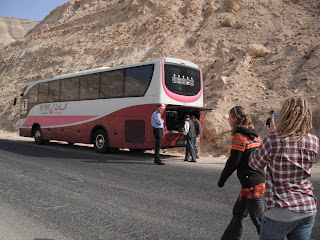So today was the last field study for the Physical Settings
class. It has been good looking at the land in such a way as it relates to the
Bible and the stories that happen in and around those times. I am continually
amazed at the vast differences that are here in the land. The regions are close
and play off of each other in interesting ways.
We started off
today at Karak. This is probably the site of Kir that is mentioned in the
Bible. There is a crusader castle that is there now. When the Israelites pushed
westwards this was one of the areas into which they pushed. There is a story
here of a battle against the king of Moab, Mesha. (2 Kings 3) It ends when a son is sacrificed
on the walls of the castle, and Israel returns home. It is unclear about whose
son it is that is sacrificed but it apparently is a game changer.
After this we headed North towards Dibon, the capital of Moab in
the Medeba Plateau. We got have way up the other side of the Yarnon Canyon and
our bus decided it was a great place to hang out for a couple hours waiting for
mechanic and a new bus J. It was quite the view and it definitely struck me
how separating this canyon really can be. While we were here we talked about
how the different regions push in different directions to get more land. The
Edomites push westward to get a hold of the Negev. The Moabites push north to
the Medeba plateau. Each nation is trying to push to be able to get more
resources, more land and more access to the trade routes that come through
here.
The Medeba map is a mosaic that was found on a floor in a church. It is interesting the perspective that the people back then had of the world and how places related to each other. Apparently Jerusalem was a very important city to them.
 |
| Jerusalem |
We ended the course with looking over the land. Throughout the
Old Testament the land and the promise of the land play a very important role
in the lives and the faith of the people. Yet when it comes to the New
Testament the idea with the land tends to shift a little. Acts is started with
a verse that tells the disciples that they are to go from Jerusalem, to Judea,
to Samaria and the Ends of the Earth. No longer is the gospel and salvation
limited to a single group of people in a particular land with set customs.
I appreciate it
being pointed out that the land portion of the promise was never fulfilled in
the fullest sense of it. The land was briefly ‘theirs’ while those on the coast
didn’t challenge them too much. It is a sense of ‘Now-and-not-yet.’ This term
was used plenty by a couple of professors that I had in undergrad and I think
that it accurately described much of what we experience. We have some of the
promise now, but much of it is still to come. Hebrews 12 talks about his as
well. The Patriarchs had time where they did not have the promise to the full,
they had time and opportunity to walk away from it all and yet they stuck to it
and they have been rewarded for it.
This faith,
this gospel is passed onto us and now we have the opportunity to carry it
forward. We are no longer bound by geography, we are to carry the message to
the ends of the earth, and we have the example of faith from those who have
gone on before us and Paul tells us that they are a great cloud of witnesses
that surround us.












No comments:
Post a Comment